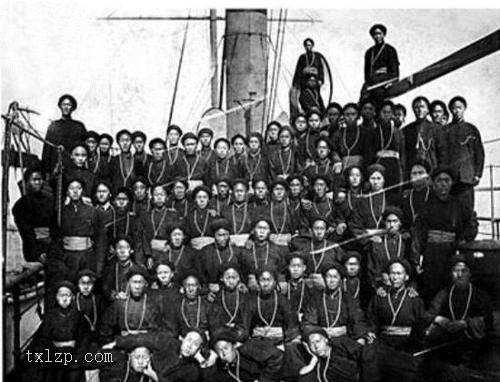Period:Tang dynasty Production date:728 (Date recorded for the death of general Liu Tingxun.)
Materials:earthenware
Technique:glazed
Subjects:spirit
Dimensions:Height: 37.60 inches
Description:
Part of a group of ‘sancai’ tomb figures comprising two earth spirits, two ‘lokopala’ and two civil officials. Figure of an earth-spirit. Made of green, brown glazed earthenware.
IMG
![图片[1]-figure BM-1936-1012.224-China Archive](https://chinaarchive.net/Tang dynasty/43/mid_00351627_001.jpg)
![图片[2]-figure BM-1936-1012.224-China Archive](https://chinaarchive.net/Tang dynasty/43/mid_00091309_001.jpg)
![图片[3]-figure BM-1936-1012.224-China Archive](https://chinaarchive.net/Tang dynasty/43/mid_00122471_001.jpg)
![图片[4]-figure BM-1936-1012.224-China Archive](https://chinaarchive.net/Tang dynasty/43/mid_00035356_001.jpg)
![图片[5]-figure BM-1936-1012.224-China Archive](https://chinaarchive.net/Tang dynasty/43/mid_00505346_001.jpg)
![图片[6]-figure BM-1936-1012.224-China Archive](https://chinaarchive.net/Tang dynasty/43/mid_Sancai_tomb_figures.jpg)
Comments:Rawson 1992:This figure is part of a group of thirteen tomb figures said to have come from the tomb of the general Liu Tingxun, who died in AD 728 and was buried at Luoyang. This group includes two earth spirits, two ‘lokapalas’ (Buddhist guardian figures), two civil servants, two horses, two camels and three grooms. All these figures would have been placed at the entrance to the main burial chamber, or just inside it. Michaelson 2006:Tomb guardians were placed in Chinese tombs from at least the Han dynasty. They would have been made specifically to protect the tomb occupant from malevolent forces. The ‘sancai’ glaze contains the oxides of various metals such as iron, zinc, copper, cobalt and manganese. In the firing these were transmuted into rich tones of yellow, green, brown and blue. Many of these protective figures, beasts and demons were extremely substantial and lifelike and often included models of Confucian officials, intended to confirm the rank of the deceased to the officials of the afterlife. See also BM 1936.1012.221, 222, 223, 220, 225.Human-headed tomb figures, such as this one, would have been placed with Buddhist ‘lokapala’ figures to guard the body in burial. Eyes glaring, they bare their teeth in a furious grimace and sink their claws into the ground. Such beasts are ferocious, with spiky wings, weapons such as a halberd, and long horns protruding from behind their heads. This figure and the others in this group are said to be from the tomb of Liu Tingxun on the basis of an article in ‘The Burlington Magazine’ (January 1921) written by R.L. Hobson. At that time the figures were on loan to the V&A Museum. In this illustrated essay Hobson states that a rubbing of the epitaph tablet from the tomb of Liu Tingxun “followed the figures to this country”. It was translated by Arthur Waley and is quoted in the article. The location of this epitaph rubbing is unknown.
Materials:earthenware
Technique:glazed
Subjects:spirit
Dimensions:Height: 37.60 inches
Description:
Part of a group of ‘sancai’ tomb figures comprising two earth spirits, two ‘lokopala’ and two civil officials. Figure of an earth-spirit. Made of green, brown glazed earthenware.
IMG
![图片[1]-figure BM-1936-1012.224-China Archive](https://chinaarchive.net/Tang dynasty/43/mid_00351627_001.jpg)
![图片[2]-figure BM-1936-1012.224-China Archive](https://chinaarchive.net/Tang dynasty/43/mid_00091309_001.jpg)
![图片[3]-figure BM-1936-1012.224-China Archive](https://chinaarchive.net/Tang dynasty/43/mid_00122471_001.jpg)
![图片[4]-figure BM-1936-1012.224-China Archive](https://chinaarchive.net/Tang dynasty/43/mid_00035356_001.jpg)
![图片[5]-figure BM-1936-1012.224-China Archive](https://chinaarchive.net/Tang dynasty/43/mid_00505346_001.jpg)
![图片[6]-figure BM-1936-1012.224-China Archive](https://chinaarchive.net/Tang dynasty/43/mid_Sancai_tomb_figures.jpg)
Comments:Rawson 1992:This figure is part of a group of thirteen tomb figures said to have come from the tomb of the general Liu Tingxun, who died in AD 728 and was buried at Luoyang. This group includes two earth spirits, two ‘lokapalas’ (Buddhist guardian figures), two civil servants, two horses, two camels and three grooms. All these figures would have been placed at the entrance to the main burial chamber, or just inside it. Michaelson 2006:Tomb guardians were placed in Chinese tombs from at least the Han dynasty. They would have been made specifically to protect the tomb occupant from malevolent forces. The ‘sancai’ glaze contains the oxides of various metals such as iron, zinc, copper, cobalt and manganese. In the firing these were transmuted into rich tones of yellow, green, brown and blue. Many of these protective figures, beasts and demons were extremely substantial and lifelike and often included models of Confucian officials, intended to confirm the rank of the deceased to the officials of the afterlife. See also BM 1936.1012.221, 222, 223, 220, 225.Human-headed tomb figures, such as this one, would have been placed with Buddhist ‘lokapala’ figures to guard the body in burial. Eyes glaring, they bare their teeth in a furious grimace and sink their claws into the ground. Such beasts are ferocious, with spiky wings, weapons such as a halberd, and long horns protruding from behind their heads. This figure and the others in this group are said to be from the tomb of Liu Tingxun on the basis of an article in ‘The Burlington Magazine’ (January 1921) written by R.L. Hobson. At that time the figures were on loan to the V&A Museum. In this illustrated essay Hobson states that a rubbing of the epitaph tablet from the tomb of Liu Tingxun “followed the figures to this country”. It was translated by Arthur Waley and is quoted in the article. The location of this epitaph rubbing is unknown.
© Copyright
The copyright of the article belongs to the author, please keep the original link for reprinting.
THE END



![[Qing Dynasty] British female painter—Elizabeth Keith, using woodblock prints to record China from the late Qing Dynasty to the early Republic of China—1915-China Archive](https://chinaarchive.net/wp-content/uploads/2022/11/image-191x300.png)

